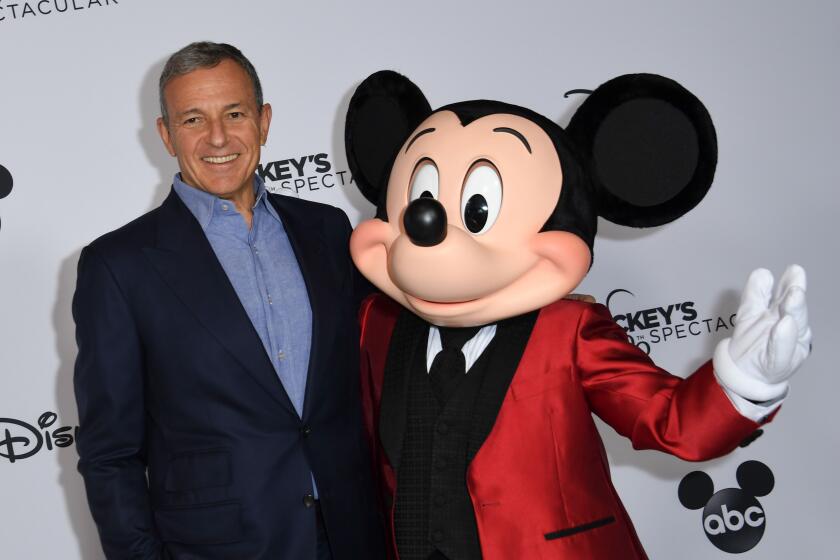‘Invisible Woman’ costume designer punctuates films with precise clothing
Costume designer Michael O’Connor knows something about period costumes, having won an Oscar for his work on “The Duchess” (set in the 17th century) as well as having been nominated for the 19th century period film “Jane Eyre.”
His latest, “The Invisible Woman,” directed by and starring Ralph Fiennes and set in mid-1800s England, is the little-known love story of Charles Dickens (Fiennes) and his secret mistress Nelly Ternan (Felicity Jones). When we meet him, Dickens is married with 10 children and at the height of his fame as a writer and storyteller, and his need to hide Ternan is strong.
O’Connor says he enjoys watching how fashion makes its evolution throughout the decades, both “subtle and unsubtle.” “People think, right, 19th century. It’s bustles and fussy detail. But each decade is very different. It’s like trying to say 20th century fashion is one or two things.”
VIDEO: Watch the cast and crew discuss ‘The Invisible Woman’
What are the pleasures of doing this kind of period work?
One of the pleasures afterward is when people say that the world onscreen felt real, and it didn’t feel costume-y or fake. For me, it’s hard to judge that. All of the costumes were made specifically for the principal characters, and the fun part for me is finding all the trims and braids and buttons and all that — it’s challenging, but it’s a pleasure to do it. It’s just a piece of flat material before, and then it feels like something that could have been bought as a real dress at the time. That is the reality that I am trying to create.
You took a very realistic approach to the era. How does that differ from stylizing the time period?
For me, it means finding out the reality of these people or as much as you can about the real clothes that they wore. So a lot of that means researching not just what they looked like on the outside but how things were put together, how they were made, the type of cloth they used, how the construction of the undergarments were. To Ralph, the more real the clothes were, it was more useful to [create] the actors’ characters.
So if you stylized it, maybe leave certain colors, certain materials, certain details out, make it less restricting and, dare I say it, less fussy and less decorated, for us was not the way to go. Once you embrace the period, we’d see these details emerge. Like the amount of flowers women wore on their bonnets. If you look at the ones of the time, you see they are incredible. You know you can go many ways with these things, but if you go the fully real way, you become a great admirer of what those people did and produced.
PHOTOS: Oscars 2014 top nominees | Nominee reactions | Snubs and surprises
Did reading Dickens’ work help with the costumes?
It was important to read Dickens’ work and know it because that’s where I find little snippets, such as how he liked girls to wear light, pastel colors and how his favorite flower was a geranium. Some of the female characters in his novels we know are based on people around him, and he’s writing contemporary. So when he’s commenting on someone’s style of dress, it’s just extra source material for us, really.
How did the character of Nelly evolve in her dress?
When we’re first introduced to Nelly, Ralph wanted her not to be the center of attention, which I thought was a good move. We put her in a quiet little gray dress as she arrives in Manchester. She doesn’t have the beauty or the talent of the others, but somehow Dickens takes an interest in her. Then in the evening she’s in a pale dress, as Dickens likes girls in soft and feminine looks. As she gains some independence, then we see her in darker, more mature, substantial colors.
If you didn’t know Kristin Scott Thomas played Nelly’s mother, you might not recognize her. How involved was she with her costumes?
Kristin was quite keen to be comfortable, to make the costumes as light as possible. She’s good in terms of design and likes strong shapes, strong stripes, strong checks, and then we used dark blues and browns. One particular dress that she hadn’t seen had quite a lot of trim on it, with lace and baubles. She wore it at Nelly’s birthday party, and I thought, she’s going to think it’s a bit fussy, but I think it was one of her favorites. She’s a smart woman, and I think at these initial meetings she realized that for this period it is about the trims and decorations.
More to Read
Only good movies
Get the Indie Focus newsletter, Mark Olsen's weekly guide to the world of cinema.
You may occasionally receive promotional content from the Los Angeles Times.










